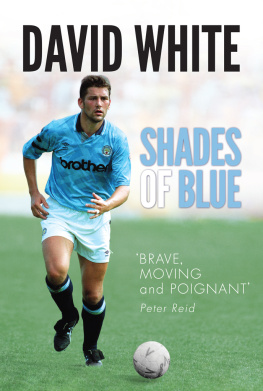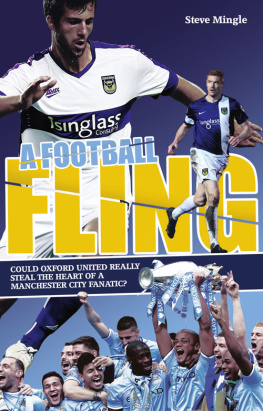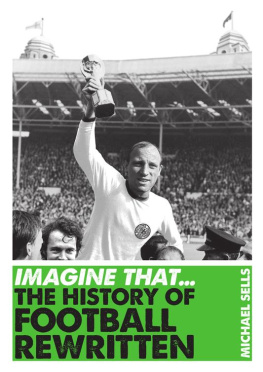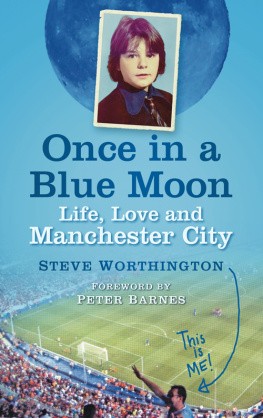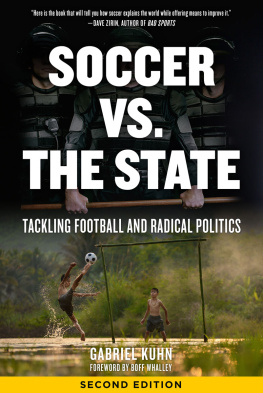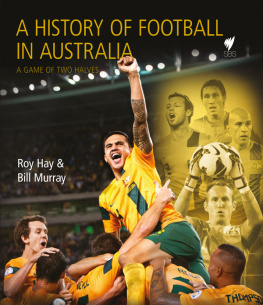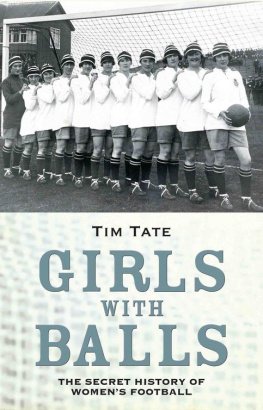The emergence of footballing cultures
The emergence of footballing cultures
Manchester, 18401919
GARY JAMES
Manchester University Press
Copyright Gary James 2019
The right of Gary James to be identified as the author of this work has been asserted by him in accordance with the Copyright, Designs and Patents Act 1988.
Published by Manchester University Press
Altrincham Street, Manchester M1 7JA
www.manchesteruniversitypress.co.uk
British Library Cataloguing-in-Publication Data
A catalogue record for this book is available from the British Library
ISBN 978 1 5261 1447 1 hardback
First published 2019
The publisher has no responsibility for the persistence or accuracy of URLs for any external or third-party internet websites referred to in this book, and does not guarantee that any content on such websites is, or will remain, accurate or appropriate.
Typeset by
Servis Filmsetting Ltd, Stockport, Cheshire
To Mancunians and those with an interest in Manchester around the globe. Also dedicated to my wife, Heidi, who has provided constant support throughout our adult lives.
Contents
A significant number of people have contributed to this publication, including library staff, archivists and curators at a variety of locations across Europe. These include the British Library, the British Newspaper Library, The National Archives, the North-West Film Archive at Manchester Metropolitan University, Manchester Central Library, the Rylands Library at Manchester University, Heritage Quay, Tameside Libraries, the Peoples History Museum, the British Film Institute, World of Rugby Museum, Manchester City, Manchester United, Rochdale FC, Oldham Athletic, Bury FC, Stockport County, the Manchester FA, Lancashire, FA, the Football Association, the Professional Footballers Association and the National Football Museum. In addition, I have explored the private and personal collections of former players, managers, supporters and directors of the Manchester regions football clubs. The support of a considerable number of individuals is appreciated and these include: Eric Alexander, Len Balaam, Phil Brennan, Tony Bugby, Tony Collins, Dave Day, Alan Hardy, Brian Houghton, John Hughson, Mike Pavasovic, Dil Porter, Dave Russell, Gordon Sorfleet, Gordon Taylor, Matthew Taylor, Wray Vamplew and Mark Wylie. I am also grateful to fellow members of the North American Society for Sports History and the British Society of Sports History who offered advice and support and questioned my material and findings. I would also like to thank everyone at De Montfort University for their support and interest, especially Martin Polley, and the delegates and supporters of the International Football History conference, including Chris Bolsmann, Brian Marwood and Stefan Szymanski. The management and staff at Manchester University Press, especially Tom Dark and Rob Byron, have been supportive throughout, demonstrating great patience and helpfulness during several significant delays over the last couple of years. I would also like to thank my family for their continuing support throughout the research and writing of this book, during which their support and enthusiasm has encouraged me.
Finally, thanks to those purchasers and readers of this book who, I hope, will gain a great deal from the material produced and the research performed: without readers, our work means little. I hope you enjoy this journey through Manchesters formative footballing experiences.
| CCC | County Cricket Club |
| CE | Common Era |
| FA | Football Association |
| FC | Football Club |
| IFAB | International Football Association Board |
| L&YR | Lancashire and Yorkshire Railway |
| LFA | Lancashire Football Association |
| MFA | Manchester Football Association |
| MSFA | Manchester Schools Football Association |

Traditionally, association footballs history has been told through a range of narratives that have focused either on the national picture or on specific clubs, with some studies focusing on how football was introduced, developed and propagated across a region.
Prior to 1919 Manchester was the scene of a series of developments which
Before progressing through Manchesters footballing development, it is essential to outline what is meant by Manchester in this book. By the 1840s it had become commonplace to discuss Manchester as the commercial centre of a vast region of towns and villages which had merged into one city-region, regardless of administrative areas. As communities are not restricted by imaginary boundary lines there is flexibility, of course, but within those eight miles are the cities of Manchester and Salford and a series of satellite towns such as Altrincham, Ashton-under-Lyne, Stockport and Hyde, which were connected to Manchester by transport links and, in some areas, an unbroken chain of housing and urbanisation. Some of these towns were boroughs within Lancashire and some were in Cheshire, while the counties of Derbyshire and Yorkshire were also a mere twelve miles from Manchester city centre, adding a level of complexity that was not apparent when walking the streets or kicking a ball around the neighbourhood.
Manchesters city boundaries were still expanding into the twentieth century, with the last major changes coming in 1931 (Wythenshawe) and 1974 (Ringway), when parts of Cheshire were added. Much of east Manchester was still, politically at least, regarded as separate independent boroughs before 1890, while areas such as Moss Side and Didsbury in the south became part of Manchester only in 1904. Even today, west of the city, Trafford, where These points can be illustrated, within a sporting context, by the use of the Manchester name. Lancashire County Cricket Club, when first established, utilised the Manchester name, yet it resided outside of the city, as did the rugby team Manchester Football Club. If those clubs considered themselves as Mancunian, then an analysis of Manchester must include them. The ties that bind the conurbation became strong over the nineteenth and twentieth centuries, ensuring that political boundaries never stood in the way of Manchesters footballing communities.
One of the issues in writing a historical analysis of a subject is that we know our current position, and that can cloud our judgement. Within Manchesters footballing histories some have assumed that the modern-day United, for example, is an indicator of what that club has always been, and this has shaped some analysis of the club. For example, during the 1990s, as United found domestic and European success, Harding claimed that the United of 1908 was the most glamourous and popular club of the era, but the facts show that to be an exaggeration. It is vital that contemporary sources are reviewed and understood without prejudice, regardless of the modern-day stature of any organisation.
Establishing a start and an end for this project was necessary, and football has some natural breaks where it is possible to see the conclusion of a transformational period. This book varies from others in taking as its end 1919, rather than the more typical 1915, when football was suspended due to the First World War. The decision to use this later date was reached after detailed investigation into the Manchester United fixed-match scandal of 1915. On the face of it, that game means little, other than that it highlights the greed of some football players; but when a full analysis is made it becomes apparent that this event was the catalyst for a new, transformational period. The scandal could be said to have been the most visible episode in a chain of activities which reached their conclusion in 1919. While 1915 may seem an appropriate point to end a book on footballs development, in Manchesters case it was 1919 that brought resolution to the pre-war issues and transformed both the League structure and perceptions of players.


